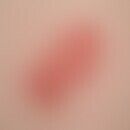Synonym(s)
DefinitionThis section has been translated automatically.
Rare pseudolymphoma localized at the contact site by a "contact allergic" also"photocontact allergic" also "aerogenic" mechanism with clinical and histological criteria and aspects of contact allergic dermatitis and cutaneous T-cell lymphoma.
Occurrence/EpidemiologyThis section has been translated automatically.
Epidemiological data are not available. The disease is extremely rare. m>w
You might also be interested in
EtiopathogenesisThis section has been translated automatically.
Special contact allergic reaction to different types of food allergens.
The following allergens are listed in the literature: methylisothiazolinone , benzydamine hydrochloride, minoxidil, metals such as gold, cobalt, nickel and 4-tert-butylphenol.
ManifestationThis section has been translated automatically.
40-60 years; the average in a larger study (n= 23 patients) was 58.5 years.
ClinicThis section has been translated automatically.
The clinical picture is similar to contact allergic eczema and is therefore limited to the site of application.
HistologyThis section has been translated automatically.
Histologically there are characteristics of a Mycosis fungoides.
Note(s)This section has been translated automatically.
Lymphomatoid tissue reactions, which describe tissue reactions that have a "lymphoma-like aspect", belong to the category of "pseudo-lymphomas". Pseudolymphomas after systemic medication are described in a large number of drugs (see below lymphocytic drug reactions) and are characterized by a very different clinical morphology.
LiteratureThis section has been translated automatically.
- Alvarez-Garrido H et al (2010) Lymphomatoid photocontact dermatitis to benzydamine hydrochloride. Contact dermatitis 62: 117-119
- Conde-Taboada A et al (2007) Lymphomatoid contact dermatitis induced by gold earrings. Contact Dermatitis 56: 179-181
- Evans AV et al (2003) Lymphomatoid contact dermatitis to para-tertyl-butyl phenol resin. Clin Exp Dermatol 28: 272-273.
- Ezzedine K etg al. (2007) Lymphomatoid contact dermatitis to an exotic wood: a very harmful toilet seat. Contact Dermatitis 57:128-130
- García-Rodiño S et al (2015) Persisting allergic patch test reaction to minoxidil manifested as cutaneouslymphoid
hyperplasia.contact dermatitis 72:413-416. - Hession MT et al (2010) Lymphomatoid allergic contact dermatitis mimicking cutaneous T cell lymphoma. Dermatitis 21:220
- Houck HE et al (1997) Lymphomatoid contact dermatitis caused bynickel. Am J Contact Dermat 8: 175-176
- Knackstedt TJ etg al.(2015) T cell lymphomatoid contact dermatitis: a challenging case and review of the literature. Contact Dermatitis 72: 65-74
- Marlière V et al (1998) Lymphomatoid contact dermatitis caused byisopropyl-diphenylenediamine: two cases. J Allergy Clin Immunol 102:152-153
- Narganes LM et al (2012) Lymphomatoid dermatitis caused by contact with textile dyes. Contact Dermatitis 68: 62-64
- Orbaneja JG et al (1976) Lymphomatoid contact dermatitis: a syndrome produced by epicutaneous hypersensitivity with clinical features and a histopathologic picture similar to that of mycosis fungoides. Contact dermatitis 2:139-143
- Schena D et al (1995) Lymphomatoid-like contact dermatitis from cobalt naphthenate. Contact dermatitis 33:197-198
- Van Steenkiste E et al (2015) Airborne-induced lymphomatoid contact dermatitis caused by methylisothiazolinone. Contact Dermatitis 72: 237-240
Incoming links (1)
Lymphomatoid contact dermatitis;Outgoing links (8)
Cobalt salts; Cutaneous t-cell lymphomas; Drug reaction lymphocytic; Gold dermatitis; Methylisothiazolinone; Nickel allergy; Photoallergic dermatitis; Pseudolymphomas of the skin (overview);Disclaimer
Please ask your physician for a reliable diagnosis. This website is only meant as a reference.





